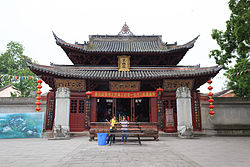Five manifestations of Shangdi
(Redirected from Wufang Shangdi)
The Five manifestations of Shangdi are in Chinese religion, the five manifestations of Shangdi. This idea dates to the Shang dynasty.[2]
| Five Forms of the Highest Deity | |||||||||
|---|---|---|---|---|---|---|---|---|---|

| |||||||||
| Modern fresco representing the Five Deities | |||||||||

| |||||||||
| Diagram of the associations from the Huainanzi[1] | |||||||||
| Simplified Chinese | 五方上帝 | ||||||||
| |||||||||
| Five Deities | |||||||||
| Chinese | 五帝 | ||||||||
| |||||||||
The five are
Five Manifestations Of Shangdi Media
Temple of the Central Peak, Mount Song, in Henan.
Tablet in the Temple of Heaven of Beijing, written in Chinese and Manchu, dedicated to the Five Deities. The Manchu word usiha, meaning "star", explains that this tablet is dedicated to the five planets: Jupiter, Mars, Saturn, Venus and Mercury and the movements which they govern.
References
- ↑ Sun & Kistemaker (1997), p. 121.
- ↑ Didier, John C. (2009). "In and Outside the Square: The Sky and the Power of Belief in Ancient China and the World, c. 4500 BC – AD 200". Sino-Platonic Papers. Victor H. Mair (192).







